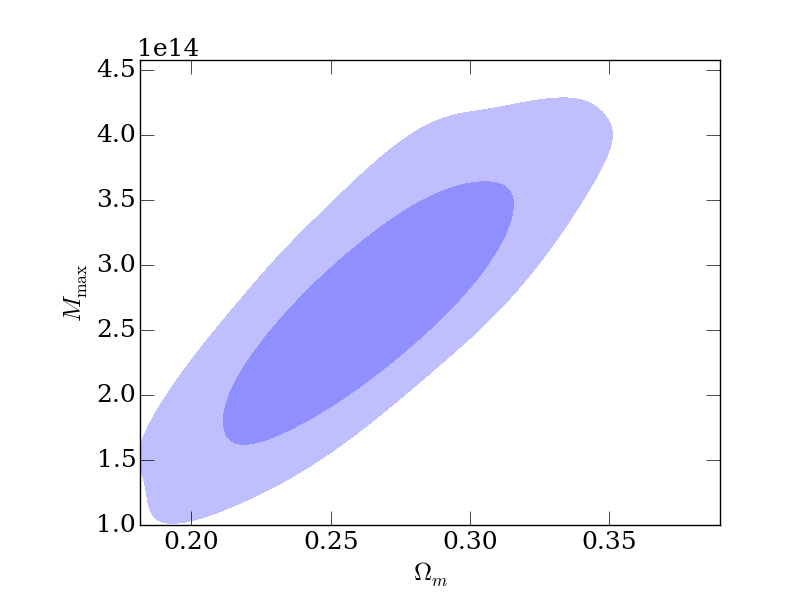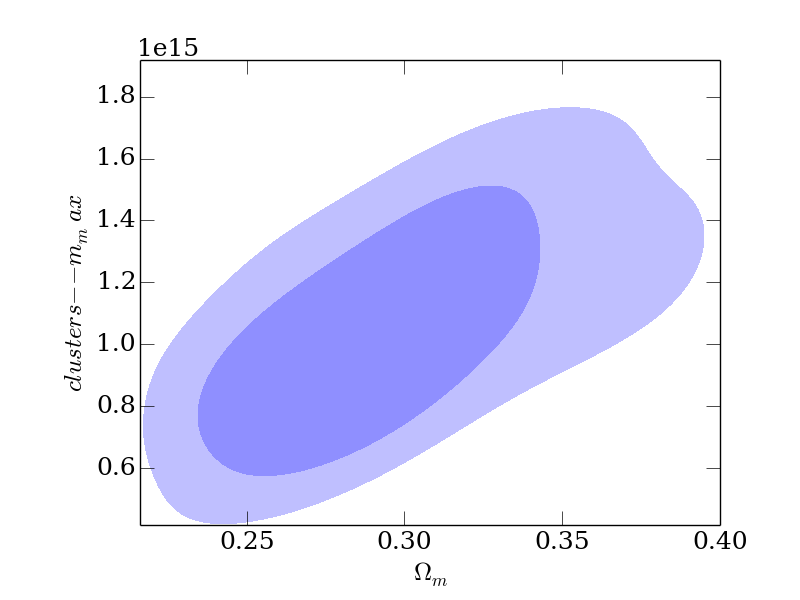Wiki
Clone wikicosmosis / example_c
Example C: Sampling a maximum cluster mass likelihood
Running
In this example we generate the maximum cluster mass likelihood at z=1.6 using the emcee sampler run in parallel, and data from Santos et al 2011 (Table 1 of Harrison & Coles 2012).
Run the demo on 4 processors using:
#!bash source config/setup-cosmosis mpirun -n 4 cosmosis --mpi demos/example_c.ini
This is a longer example that will take about an hour to run. You can generate the plots of the output using
#!bash postprocess -o plots -p example_c demos/example_c.ini --burn 1000

You will get some summary statistics, as with the other samplers in demos three, five and nine, for example:
#!text Marginalized mean, std-dev: cosmological_parameters--omega_m = 0.258313 ± 0.0282911 clusters--m_max = 2.55063e+14 ± 6.13247e+13 like = -66.3245 ± 0.979674 Marginalized median, std-dev: cosmological_parameters--omega_m = 0.258094 ± 0.0282911 clusters--m_max = 2.49112e+14 ± 6.13247e+13 like = -66.035 ± 0.979674 Best likelihood: cosmological_parameters--omega_m = 0.26646 clusters--m_max = 2.71106e+14 like = -65.2116
Understanding
The sampling
We are now using a proper MCMC sampler, called emcee. This sampler is described in http://arxiv.org/abs/1202.3665 . See demo 5 on the wiki for a shorter example of how to use this sampler. In this run we are using 16 walkers and 200 samples which should be enough as we are only varying two parameters M_max and Omega_m.
The pipeline for this run is the same as in demo 13
#!bash [pipeline] modules = consistency camb mf_tinker evs cluster_mass likelihoods = evs maxmass
In this example we are running the "evs" module with "output_pdf = F" to speed up the sampling time. See demo 13 for more details on each of the modules in the pipeline. In this example we are allowing the M_max and omega_m parameters to vary in fitting to the Santos et al 2011 cluster mass measurement at z=1.5.
If you want to edit this demo to output likelihoods for a cluster mass at another redshift you can do this by modifying the .ini file for camb, evs and cluster_mass modules. Let's say we have some cluster mass data like Menanteau et al 2011 's "El Gordo" at z=0.87 then we need to output power spectra from camb in a redshift range around this target and get the max mass PDF using
#!bash [camb] file = cosmosis-standard-library/boltzmann/camb/camb.so zmin = 0.5 zmax = 1.0 nz = 40 [evs] file =cosmosis-standard-library/likelihood/cluster_evs/cluster_evs.py ; Redshift of observed cluster redshift = 0.9 ;Fraction of sky observed to get cluster frac = 1.0 output_pdf = F
We can input the cluster mass data in the .ini file as
[cluster_mass] file = cosmosis-standard-library/likelihood/cluster_mass/cluster_mass.py ;See Menanteau et al 2011, Harrison & Coles 2012 Table 1 (masses converted to M_sun/h) mean = 1.295e+15 sigma = 2.94e+14

Updated